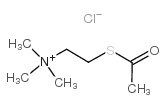acetylthiocholine chloride

acetylthiocholine chloride structure
|
Common Name | acetylthiocholine chloride | ||
|---|---|---|---|---|
| CAS Number | 6050-81-3 | Molecular Weight | 197.72600 | |
| Density | N/A | Boiling Point | N/A | |
| Molecular Formula | C7H16ClNOS | Melting Point | N/A | |
| MSDS | Chinese USA | Flash Point | N/A | |
| Symbol |

GHS05 |
Signal Word | Danger | |
|
An acetylcholinesterase (AChE) biosensor with enhanced solvent resistance based on chitosan for the detection of pesticides.
Talanta 146 , 279-84, (2015) Solvent tolerance of immobilized enzymes is important for many biosensing and biotechnological applications. In this paper we report an acetylcholinesterase (AChE) biosensor based on chitosan that exhibits high solvent resistance and enables sensitive detecti... |
|
|
Disposition and acute toxicity of imidacloprid in female rats after single exposure.
Food Chem. Toxicol. 68 , 190-5, (2014) Single dose of imidacloprid (IMI-20mg/kg bodyweight) was orally administered in female rats. Its disposition along with two metabolites 6-chloro nicotinic acid (6-CNA) and 6-hydroxy nicotinic acid (6-HNA) was monitored in organs (brain, liver, kidney, and ova... |
|
|
Silibinin inhibits acetylcholinesterase activity and amyloid β peptide aggregation: a dual-target drug for the treatment of Alzheimer's disease.
Neurobiol. Aging 36 , 1792-807, (2015) Alzheimer's disease (AD) is characterized by amyloid β (Aβ) peptide aggregation and cholinergic neurodegeneration. Therefore, in this paper, we examined silibinin, a flavonoid extracted from Silybum marianum, to determine its potential as a dual inhibitor of ... |
|
|
Synthesis and characterization of 1H-phenanthro[9,10-d]imidazole derivatives as multifunctional agents for treatment of Alzheimer's disease.
Biochim. Biophys. Acta 1840(9) , 2886-903, (2014) Alzheimer's disease (AD) is a progressive neurodegenerative brain disorder that is characterized by dementia, cognitive impairment, and memory loss. Diverse factors are related to the development of AD, such as increased level of β-amyloid (Aβ), acetylcholine... |
|
|
Detection of glycoalkaloids using disposable biosensors based on genetically modified enzymes.
Anal. Biochem. 457 , 85-90, (2014) In this work we present a rapid, selective, and highly sensitive detection of α-solanine and α-chaconine using cholinesterase-based sensors. The high sensitivity of the devices is brought by the use of a genetically modified acetylcholinesterase (AChE), combi... |
|
|
Syncytin proteins incorporated in placenta exosomes are important for cell uptake and show variation in abundance in serum exosomes from patients with preeclampsia.
FASEB J. 28(8) , 3703-19, (2014) Exosomes are extracellular vesicles that mediate intercellular communication and are involved in several biological processes. The objective of our study was to determine whether endogenous retrovirus group WE, member l (ERVWE1)/syncytin-1 and endogenous retr... |
|
|
Discovering New Acetylcholinesterase Inhibitors by Mining the Buzhongyiqi Decoction Recipe Data.
J. Chem. Inf. Model. 55 , 2455-63, (2015) Myasthenia gravis (MG) is a neuromuscular disease that is conventionally treated with acetylcholinesterase (AChE) inhibitors, which may not fully remove the symptom for many reasons. When AChE inhibitors do not work, Chinese patients turn to Chinese medicine,... |
|
|
Discovery of multitarget-directed ligands against Alzheimer's disease through systematic prediction of chemical-protein interactions.
J. Chem. Inf. Model. 55(1) , 149-64, (2015) To determine chemical-protein interactions (CPI) is costly, time-consuming, and labor-intensive. In silico prediction of CPI can facilitate the target identification and drug discovery. Although many in silico target prediction tools have been developed, few ... |
|
|
Exonuclease I-aided homogeneous electrochemical strategy for organophosphorus pesticide detection based on enzyme inhibition integrated with a DNA conformational switch.
Analyst 141 , 1830-6, (2016) A novel enzyme inhibition-based homogeneous electrochemical biosensing strategy was designed for an organophosphorus pesticide assay based on exploiting the resistance of a mercury ion-mediated helper probe (HP) toward nuclease-catalyzed digestion and the rem... |
|
|
Tacrine-propargylamine derivatives with improved acetylcholinesterase inhibitory activity and lower hepatotoxicity as a potential lead compound for the treatment of Alzheimer's disease.
J. Enzyme Inhib. Med. Chem. 30 , 995-1001, (2015) A series of tacrine-propargylamine derivatives were synthesised and evaluated as possible anti-Alzheimer's disease (AD) agents. Among these derivatives, compounds 3a and 3b exhibited superior activities and a favourable balance of AChE and BuChE activities (3... |